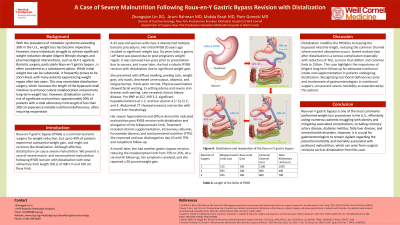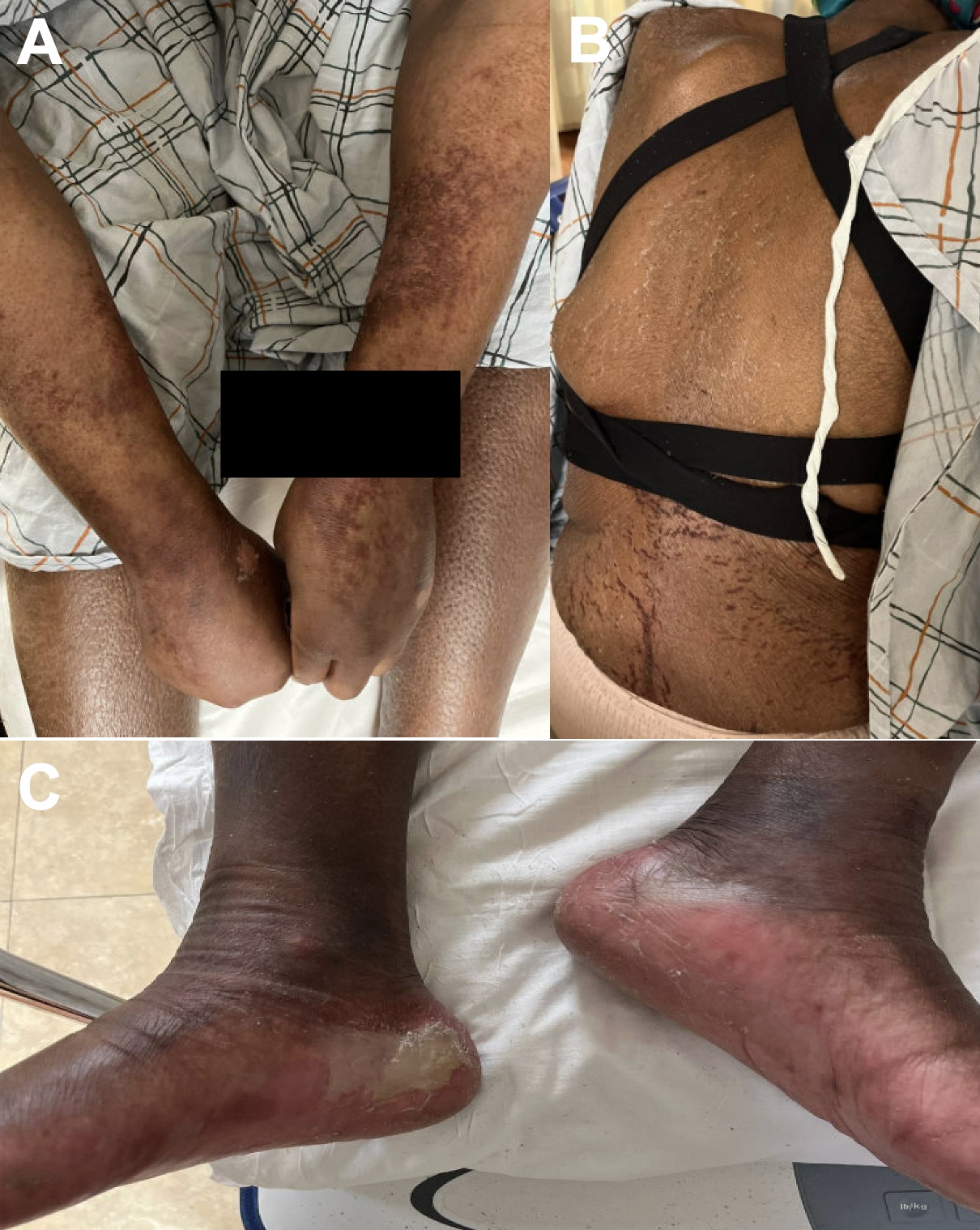Sunday Poster Session
Category: Obesity
P1458 - A Case of Severe Malnutrition Following Roux-en-Y Gastric Bypass Revision With Distalization
Sunday, October 27, 2024
3:30 PM - 7:00 PM ET
Location: Exhibit Hall E

Has Audio

Zhongqian Lin, DO
New York-Presbyterian / Brooklyn Methodist Hospital
Brooklyn, NY
Presenting Author(s)
Zhongqian Lin, DO1, Aruni Rahman, MD1, Makda Bsrat, MD2, Piotr Gorecki, MD1
1New York-Presbyterian / Brooklyn Methodist Hospital, Brooklyn, NY; 2New York Brooklyn Methodist Hospital, Brooklyn, NY
Introduction: Roux-en-Y gastric bypass (RYGB) is a common bariatric surgery for weight reduction, but up to 40% of patients experience substantial weight gain, and might use revisions like distalization. Although effective, distalization can cause severe malnutrition. We present a case of severe macro- and micronutrient malnutrition following RYGB revision with distalization with total alimentary limb length of (TALL) of 400cm and 100cm Roux limb.
Case Description/Methods: A 42-year-old woman with class-3 obesity had multiple bariatric procedures. Her initial RYGB 20 years ago resulted in significant weight loss. Six years later, a gastric LAP band was placed due to post-pregnancy weight regain. It was removed two years prior to presentation due to nausea, and a year later, she had a robotic RYGB revision with distalization
due to significant weight gain. She presented with diffuse swelling, peeling rash, weight gain, oily stools, decreased urine output, alopecia, and tongue bumps. Vitals were normal. Physical examination showed facial wasting, 2+ pitting edema and severe skin dryness with peeling. Labs revealed chronic kidney disease, Pro-BNP at 452, INR 3.3, significant hypoalbuminemia at 1.2, and low vitamin A (< 5), D, E, and K. Abdominal CT showed anasarca and ascites with normal liver morphology. Her severe hypervolemia and diffuse dermatitis indicated malnutrition post-RYGB revision with distalization and elongation of the biliopancreatic limb. Treatment included vitamin supplementation, intravenous albumin, furosemide diuresis, and total parenteral nutrition (TPN). She improved and was discharged on day 10 with TPN and outpatient follow-up. A month later, she had another gastric bypass revision, reducing the malabsorption limb from 75% to 25%. At a six-month follow-up, her symptoms resolved, and she reported a 30-pound weight gain.
Discussion: Distalization modifies the RYGB by increasing the bypassed intestine length, reducing the common channel where nutrient absorption occurs. Severe malnutrition after distalization is a serious complication especially with reduction of TALL to more than 300cm and common limb to 150cm. This case highlights the importance of diligent long-term follow-up for adequate nutritional intake and supplementation in patients undergoing distalization. Recognizing nutritional deficiencies early and involvement of gastroenterologists in nutritional support, can prevent severe morbidity as experienced by this patient.

Disclosures:
Zhongqian Lin, DO1, Aruni Rahman, MD1, Makda Bsrat, MD2, Piotr Gorecki, MD1. P1458 - A Case of Severe Malnutrition Following Roux-en-Y Gastric Bypass Revision With Distalization, ACG 2024 Annual Scientific Meeting Abstracts. Philadelphia, PA: American College of Gastroenterology.
1New York-Presbyterian / Brooklyn Methodist Hospital, Brooklyn, NY; 2New York Brooklyn Methodist Hospital, Brooklyn, NY
Introduction: Roux-en-Y gastric bypass (RYGB) is a common bariatric surgery for weight reduction, but up to 40% of patients experience substantial weight gain, and might use revisions like distalization. Although effective, distalization can cause severe malnutrition. We present a case of severe macro- and micronutrient malnutrition following RYGB revision with distalization with total alimentary limb length of (TALL) of 400cm and 100cm Roux limb.
Case Description/Methods: A 42-year-old woman with class-3 obesity had multiple bariatric procedures. Her initial RYGB 20 years ago resulted in significant weight loss. Six years later, a gastric LAP band was placed due to post-pregnancy weight regain. It was removed two years prior to presentation due to nausea, and a year later, she had a robotic RYGB revision with distalization
due to significant weight gain. She presented with diffuse swelling, peeling rash, weight gain, oily stools, decreased urine output, alopecia, and tongue bumps. Vitals were normal. Physical examination showed facial wasting, 2+ pitting edema and severe skin dryness with peeling. Labs revealed chronic kidney disease, Pro-BNP at 452, INR 3.3, significant hypoalbuminemia at 1.2, and low vitamin A (< 5), D, E, and K. Abdominal CT showed anasarca and ascites with normal liver morphology. Her severe hypervolemia and diffuse dermatitis indicated malnutrition post-RYGB revision with distalization and elongation of the biliopancreatic limb. Treatment included vitamin supplementation, intravenous albumin, furosemide diuresis, and total parenteral nutrition (TPN). She improved and was discharged on day 10 with TPN and outpatient follow-up. A month later, she had another gastric bypass revision, reducing the malabsorption limb from 75% to 25%. At a six-month follow-up, her symptoms resolved, and she reported a 30-pound weight gain.
Discussion: Distalization modifies the RYGB by increasing the bypassed intestine length, reducing the common channel where nutrient absorption occurs. Severe malnutrition after distalization is a serious complication especially with reduction of TALL to more than 300cm and common limb to 150cm. This case highlights the importance of diligent long-term follow-up for adequate nutritional intake and supplementation in patients undergoing distalization. Recognizing nutritional deficiencies early and involvement of gastroenterologists in nutritional support, can prevent severe morbidity as experienced by this patient.

Figure: Diffuse swelling with skin peeling on the patient's (A) bilateral upper extremities, (B) back, and (C) lower extremities
Disclosures:
Zhongqian Lin indicated no relevant financial relationships.
Aruni Rahman indicated no relevant financial relationships.
Makda Bsrat indicated no relevant financial relationships.
Piotr Gorecki indicated no relevant financial relationships.
Zhongqian Lin, DO1, Aruni Rahman, MD1, Makda Bsrat, MD2, Piotr Gorecki, MD1. P1458 - A Case of Severe Malnutrition Following Roux-en-Y Gastric Bypass Revision With Distalization, ACG 2024 Annual Scientific Meeting Abstracts. Philadelphia, PA: American College of Gastroenterology.
